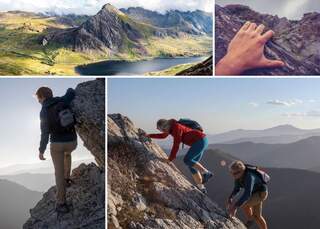To take on grade 1 routes, you shouldn’t require any additional special equipment beyond your normal walking kit. So, check the weather forecast and wear the same kit you would for a regular hill walk.
Footwear – Wear standard walking boots for good all-round protection, or approach shoes with sticky soles and good edges if you’re looking for even better grip and easier foot placement. Choosing between shoes and boots really comes down to personal preference and can depend on the conditions and route. Having a pair of both is ideal or you could go for something in between like a mid-boot which is flexible enough to be comfortable, but also offers ankle support.
Clothing – The weather will impact your choice of clothing in the same way it would normal hiking. Wear a breathable base layer and mid-layer to help regulate your temperature and pack a breathable and waterproof jacket in case the weather changes. In terms of your lower half, comfortable, lightweight walking trousers will allow you to move freely over the rocks, but if you are after more protection, look for clothing with extra reinforcement around the knees and elbows.
Pack – Taking a lightweight daypack big enough to carry just the essentials you need, rather than larger, bulkier packs will make the scrambling sections much easier to negotiate.
Scrambling Guidebooks – Don’t expect to find signposts or obvious tracks to follow up a scrambling route. There are normally different route options to consider and that’s part of the fun in reaching the summit. Guidebooks do exist for popular scrambling areas though and are highly recommended. A good guide (with pictures) will let you know the grade route in advance and help you navigate and avoid harder sections if you need to.








